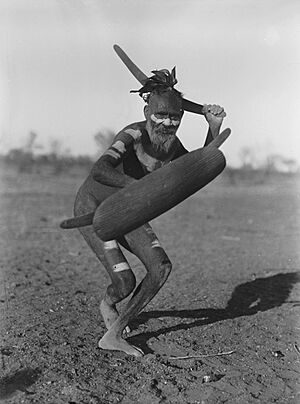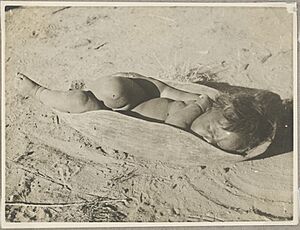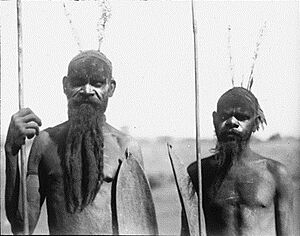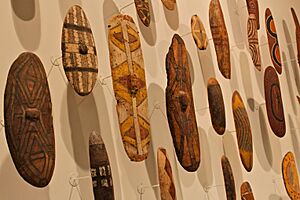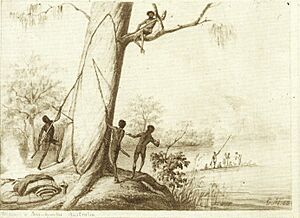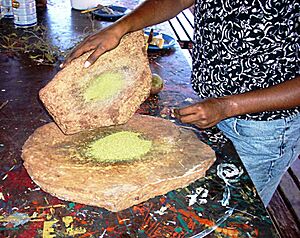Australian Aboriginal artefacts facts for kids
Australian Aboriginal artefacts are special tools and items used by Aboriginal Australians for many years. Most of these items had more than one use. For example, a spear could be for hunting or for ceremonies.
Aboriginal people used many different types of items. These included weapons like spears and boomerangs for hunting and fighting. They also had boats like dugout and bark canoes for travel and fishing. Stone tools were used for cutting and grinding food. Coolamons and dillybags helped carry water, food, and even babies. Message sticks were used to send important messages. There were also beautiful items for decoration and special events. Even toys for children helped them learn and have fun.
Contents
Weapons
Aboriginal people used many kinds of weapons. These included shields (also called hielaman), spears, spear-throwers, boomerangs, and clubs. The types of weapons used could be different depending on the region. For example, some groups used boomerangs and shields, while others used clubs. Weapons were important for hunting animals and for battles.
Weapons also looked different in various areas. A shield from Central Australia, for instance, would look very different from one made in North Queensland.
Spears
Spears were used by Aboriginal people for many things. They used them for hunting, fishing, gathering fruit, and fighting. Spears were also part of ceremonies and could be traded. They even showed a man's masculinity. In the past, spears were thrown by hand. But later, people started using spear-throwers. These tools helped throw spears further and more accurately.
Spears were made from different materials. These included soft woods, bamboo, cane, and reeds. The sharp points of spears could be made from flaked stone, shell, wood, kangaroo bone, or even fish teeth. More recently, people used iron, glass, or ceramics. These points were attached to the spear using sticky plant resins, glues, string, or plant fibres.
Clubs
An Aboriginal club, also known as a waddy or nulla-nulla, had many uses. It could be used for hunting, fishing, digging, and fighting. Clubs were also used in ceremonies. A fighting club called a 'Lil-lil' could cause serious injury with a strong hit. Clubs that caused severe damage were made from very hard woods. These included acacia trees like ironwood. Many clubs were hardened by fire. Some even had sharp stone pieces attached to the handle with spinifex resin.
Boomerangs

The boomerang is a well-known symbol of Australia. Most boomerangs are for hunting and do not come back to the thrower. However, a small number of boomerangs, called 'returning boomerangs', are designed to fly back. The oldest wooden boomerang found in Australia is about 9,500 years old. It was found in Wyrie Swamp, South Australia, in 1973.
Boomerangs had many uses:
- They were used as hunting or fighting weapons.
- They could be used for digging in the ground.
- Some were used as cutting knives.
- They could help start a fire by rubbing them together.
- They were also used as musical instruments.
Shields
Shields were mainly used by Aboriginal warriors to protect themselves in battles. A shield that had never been defeated was seen as very powerful and was highly valued. Shields were made from wood or bark. They often had special carvings or painted designs. Shields were also used in important ceremonies like corroborees.
There are two main types of Aboriginal shields: broad shields and parrying shields. Parrying shields are thick, strong, and narrow. They are used to deflect hits from clubs. Broad shields are wide but thin. They are used to block spears. The materials used for shields varied by region. They were made from tree roots, mulga wood, or bark. A handle was either attached or carved into the back. Shields were often painted with red and white patterns.
Shields from the North Queensland rainforest are very popular with collectors. This is because of their beautiful painted designs. These shields were made from the large roots of rainforest fig trees. They were painted with red, yellow, white, and black colors. These colors came from natural materials like ochre, clay, and charcoal. Sometimes, human blood was also used. After Europeans arrived, the color blue sometimes appeared on shields. A piece of lawyer cane would be used to make the shield owner's nose bleed. The blood was put on the shield to show that their life was connected to the object. Each shield had unique designs. These designs showed the owner's connection to their totem (a spiritual symbol) and their land. When a young Aboriginal man finished his initiation ceremony, he was given a blank shield. He would then create his own design. People believed the shield held the power and protection of the owner's totem and ancestors.
Shield Discoveries
Some important Aboriginal shields are kept in museums around the world.
- The Australian Museum has a wooden shield from the Kuku Yalanji people of the Daintree Rainforest in Cape York, Queensland.
- The British Museum has a very old and important Aboriginal shield. It is believed that Captain Cook collected it in 1770 during his first trip to Australia. This shield is called the Gweagal shield. It is about 0.97 meters long and 0.29 meters wide. It has marks on its surface, including a hole in the middle. Scientists have studied it and believe the hole was caused by a firearm during Cook's attempt to land in April 1770. The shield was taken to England and is now on display at the British Museum. It is considered a very special item because of its history and meaning for both Indigenous and non-Indigenous people.
Watercraft
Aboriginal communities used different types of boats. The most common were bark canoes and dugout canoes. These boats were built and used in different ways. The knowledge of how to build canoes was passed down through stories and teaching, not by writing or drawing. Canoes were used for fishing, hunting, and traveling.
Bark canoes
Bark canoes were usually made from the bark of Eucalyptus trees. The bark could only be taken from the tree at a certain time during the wet season. This was to avoid harming the tree and to make sure the bark was flexible. The bark was cut with axes and carefully peeled off the tree. Sometimes, more than one piece of bark was used. Today, you can still see "Canoe trees" with their unique marks where bark was removed.
The bark was shaped by heating it with fire and soaking it in water. The ends of the canoe were tied together with strong plant fibers. Branches were sometimes used to make the joints stronger. Clay, mud, or other sticky resins were used to seal any gaps. Bark canoes were light and didn't sit deep in the water. This made them perfect for calm waters like rivers, lakes, and bays. Aboriginal men would throw spears to catch fish from the canoe. Women would use hooks and lines. Paddles made of bark were used to move the canoe. Thick leafy branches could also be held up to catch the wind.
Dugout canoes
Dugout canoes were a big step forward in boat technology. They were much stronger and better for open seas and rougher conditions. These canoes were used for hunting large sea animals like dugongs and sea turtles.
Stone artefacts
Aboriginal people used stone tools every day. These included cutting tools and grinding or pounding stones. Cutting tools were made by hitting a larger stone to break off sharp flakes. Grinding stones included millstones and mullers. Quartzite was a common material for making flakes, but other hard stones were also used. Flakes could be used to make spear points, blades, or knives. Grinding stones were used to grind grass seeds into flour for bread. They also helped get marrow from bones.
Stone tools were not just for practical tasks like hunting. They also held special spiritual meaning. Indigenous Australians believe that a stone tool can hold the spirit of an ancestor who once owned it. Some grinding stones found in New South Wales are 30,000 years old. Leilira blades from Arnhem Land, collected between 1931 and 1948, are now kept at the Australian Museum.
Coolamons and carriers
Coolamons are special Aboriginal bowls. They were generally used to carry water, food, and even to hold babies. Coolamons could be made from many different materials. These included wood, bark, animal skin, and plant parts. When traveling long distances, coolamons were carried on the head. A special pad called Akartne was placed under the coolamon to help support its weight. These pads could be made from possum hair, feathers, or twisted grass.
Coolamon Discoveries
Museums around the world have collections of coolamons.
- The Australian Museum has a bark water carrying vessel from Flinders Island, Queensland, collected in 1905. This coolamon was made from a eucalyptus tree trunk that was burned and smoothed to hold water. The museum also has a water bag made from kangaroo skin, collected in 1893, from the Urania people of North-West Queensland.
- The South Australian Museum has a wooden coolamon collected in 1971.
Message sticks
Message sticks, also known as "talking-sticks," were used by Aboriginal communities to send messages. These messages could be invitations, declarations of war, or news of a death. They were made of wood and were usually flat. They had symbols carved on all sides to show the message. The type of wood and the shape of the message stick could also be part of the message. Special messengers would carry these sticks over long distances. They could travel through different tribal lands without harm. After the message was delivered, the message stick was usually burned.
Message Stick Discoveries
Many museums have collections of message sticks:
- The Australian Museum has 230 message sticks.
- The South Australian Museum has 283 message sticks.
- The British Museum has 74 message sticks.
- The National Museum of Australia has 53 message sticks.
- The Pitt Rivers Museum has a message stick from the 1800s made of Acacia homalophylla from Queensland. This stick was sent by a Yagalingu man to a Wadjalang man. It was an invitation to hunt emu and wallaby. Zig-zag symbols carved into the wood meant 'emu', and cross-hatching meant 'wallaby'. The British Museum also has a Kalkatungu message stick, collected in 1900. It was made to share the news of three children's deaths, shown by diamond-shaped carvings.
Ornamental artefacts
Some Aboriginal people used materials like teeth and bone to make beautiful items. These included necklaces and headbands.
Teeth ornaments
The most common teeth ornaments were made from the lower front teeth of macropods like kangaroos or wallabies. A very interesting discovery was a necklace made from 178 Tasmanian devil teeth. It was found in Lake Nitchie, New South Wales, in 1969. Ornaments worn on the forehead were also made from porpoise and dolphin teeth. Crocodile teeth were mostly used in Arnhem Land.
Bone ornaments
Bones were often used for decoration, especially for necklaces and pendants. These were usually worn for special rituals or to show a person's age or status. They could also be worn casually. Bone ornaments found in Boulia, Queensland, were made from the toe bones of kangaroos and dingoes. Eel bones were used as pendants by the Gulngay people. In western Victoria, echidna quills were threaded into necklaces. A pendant made from goose down, shells, and a duck beak was found near the Murray River in South Australia. Eagle talons were used in ornaments by the Arrernte of Central Australia. Necklaces made from wombat claws are known from Victoria. Painted requiem shark vertebrae necklaces have been found in western Arnhem Land.
Pearl shells
Riji are special pearl shells traditionally worn by Aboriginal men in the north-west of Australia, near Broome. The word riji comes from the Bardi language. Another name for it is jakuli. Before it is decorated, the pearl shell is called guwan. Lines called ramu are carved onto the guwan. These lines often show sacred patterns or traditional stories. Once carved, it becomes a riji. Sometimes, ochre is added to the carvings for color. Riji are connected to water, spiritual powers, healing, and life.
Clothing
Possum-skin cloak
Buka cloak
Kopis
The Kopi mourning cap was a type of hat made from clay. It was mostly worn by women of some Aboriginal groups. They wore it for up to six months after a loved one died. After cutting their hair, they would weave a net using sinews from emu. They would place this net on their head and cover it with layers of gypsum, a white clay from rivers. These caps could be heavy, sometimes weighing up to 7 kilograms. Men also sometimes wore them. When the mourning period was over, the Kopi was placed on the grave of the person who had died.
Other names for the Kopi included widow's cap, korno, mulya, mung-warro, pa-ta, and yúgarda.
Children's toys
Aboriginal children's toys were not just for fun. They also helped children learn important skills. Toys were made from different materials depending on what was available in each area.
Dolls
"Dolls" could be made from cassia nemophila plants. Their branches were put together with string and grass. Features were often painted with clay to look like a baby. Dolls made from Xanthorrhoea plants are called Kamma dolls and come from Keppel Island. Shell dolls could also be made from cone-shaped shells. They were often wrapped in fabric to show age or status.
Rattles
Rattles were made from various materials, depending on what was nearby. For example, they could be made from land snail shells, sea snail shells, or scallop shells. Walnut seeds or olive shells were also used. These items were strung together with string or hair and often painted.
Bags and baskets
In Arnhem Land, the Gulf region of Queensland, and Cape York, children's bags and baskets were made from twisted plant fibers.
Toy spears and shields
Boys used play spears, which were often blunt wooden spears, in pretend battles and throwing games. These games helped them practice skills they would need later.
Toy Collections
Museums have collections of Aboriginal children's toys:
- The Australian Museum holds 370 toys collected between 1885 and 1990. In 1899, Walter Roth found and collected three rattles from Mapoon, Batavia River, and Cape York Peninsula. The museum also has three dolls made of curved sticks and fabric from North Queensland, dating back to the early 1900s.
- The Tasmanian Museum and Art Gallery has three wooden dolls from Mornington Island.
Sacred items
Some items were considered sacred or used in special ceremonies. These included bullroarers, didgeridoos, and carved boards called churinga.
Art
Most Aboriginal art is not considered an artefact in the same way as tools. However, the designs in Aboriginal art often look similar to the designs found on sacred artefacts.
Keeping Places
A Keeping Place is a special place managed by an Aboriginal community. It is used to safely store cultural items that have been returned to their communities. These can include local heritage items, cultural artefacts, art, and important knowledge. Krowathunkooloong Keeping Place in Gippsland, Victoria, is one example. In Western Australia, there is an online system called The Keeping Place Project. It helps manage cultural heritage items.
See also


